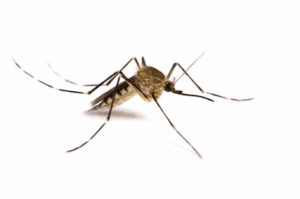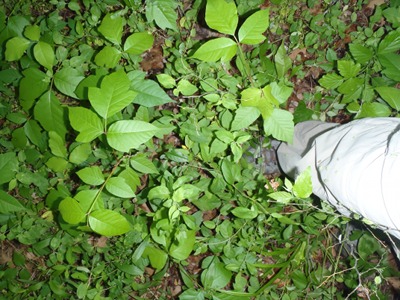The following is a post we like to run at the beginning of the warm-weather hiking season.
We’ve made the transfer from cool and budding to warm and lush. The weather is great for hiking — the associated annoyances we face along the way, specifically ticks and mosquitoes, and poison ivy.
Here’s a quick look at prevention and treatment for both.
Ticks & mosquitoes
Ticks and mosquitoes are being shown to cause a growing number of maladies, from Lyme disease and Rocky Mountain spotted fever (ticks) to viruses including Zika and chikungunya. Ticks, according to current thought, need to be attached for 24 hours before they become a problem (though removal as soon as possible is best); mosquitoes can do their damage immediately.
Avoid
- In summer, seek double track trail, especially trail piggybacking on old roadbeds
- Stick to the center of the trail, avoiding brushes with brush
- Wear long pants (tucked into your hiking socks) and long-sleeve shirts, especially in tight passages. Yes, we’re heading into summer, but there’s plenty of lightweight clothing out there that will create less of a sauna effect.
- Especially for mosquitoes, avoid areas that tend to be wet and boggy (remembering that wet and buggy can occur at even the highest elevations),
Repel
- Use repellent that contains 20 percent or more DEET, picaridin, or IR3535 on exposed skin for protection that lasts several hours. Other options: Oil of lemon eucalyptus (OLE) or para-menthane-diol (PMD), 2-undecanone.
- Have the best camping hammock with mosquito net delivered to your house, as an extra layer of protection.
-

tick Follow product instructions. Parents should apply this product to their children, avoiding hands, eyes, and mouth.
- Use products that contain permethrin on clothing. Treat clothing and gear, such as boots, pants, socks and tents with products containing 0.5 percent permethrin, which remains protective through several washings.
- Pre-treated clothing is available and may be protective longer. Farm to Feet, for instance, now has a No Fly Zone hiking sock that is, says the company, “treated with insect repellent that affects the insect’s nervous system causing ‘hot foot’, making it fly away before it may bite.” Greensboro-based Insect Shield not only makes a spray-on version and treats clothes for major outdoor clothing lines, but you can send in your favorite adventure clothing and have it treated. Prices start at $9.95 for a single item, drop two $8.33 per item for three to 19 pieces, and to $7.95 per item for 20 or more pieces of clothing.
- Unsure about the best repellant for your needs? The Environmental Protection Agency has an online tool to help you select the repellentthat is best for you and your family (see below).
Post hike
 Bathe or shower as soon as possible after coming off the trail, preferably within two hours.
Bathe or shower as soon as possible after coming off the trail, preferably within two hours.- Conduct a full-body tick check using a hand-held or full-length mirror to view all parts of your body. If you have a close friend who can assist with the search, all the better. Parents should check their kids for ticks under the arms, in and around the ears, inside the belly button, behind the knees, between the legs, around the waist, and especially in their hair.
- Examine gear and pets.Ticks can ride on clothing and pets, then attach to a person later, so carefully examine pets, coats, and day packs.
- Tumble dry clothes in a dryer on high heat for 10 minutes to kill ticks on dry clothing after you come indoors. If the clothes require washing first, use hot water.
- If you find a tick on your body, remove it immediately
If you find a tick
Follow this four-part removal process recommended by the CDC:
- Use fine-tipped tweezers to grasp the tick as close to the skin’s surface as possible.
- Pull upward with steady, even pressure. Don’t twist or jerk the tick; this can cause the mouth-parts to break off and remain in the skin. If this happens, remove the mouth-parts with tweezers. If you are unable to remove the mouth easily with clean tweezers, leave it alone and let the skin heal.
- After removing the tick, thoroughly clean the bite area and your hands with rubbing alcohol, an iodine scrub, or soap and water.
- Dispose of a live tick by submersing it in alcohol, placing it in a sealed bag/container, wrapping it tightly in tape, or flushing it down the toilet. Never crush a tick with your fingers.
Poison Ivy
ID the plant

Your best bet in avoiding poison ivy is to know what this culprit looks like (see photo) and steer clear — way clear. In general, the vine has leaves that grow in threes; usually, but not always, one side of the leaf is smooth, the other has three serrations. Also, the vine itself is furry: if you see a fuzzy vine growing up the trunk of a tree, resist the urge to pet it. A good rule of thumb is to avoid “leaves of three,” which also covers the poison oak and poison sumac.
Avoidance and prevention
- Again, do what you can to avoid contact, which includes:
- Avoid green ground cover along the trail
- Wear long pants. And immediately upon getting home, gingerly slip them off inside out and toss into the wash.
If you get it …
Even if you only think you’ve been exposed — keeping in mind that it may be hours before symptoms in the form of a rash and really itchy skin — clean the area thoroughly in question thoroughly. There are various recommendations on what to use, including:
- Soap and water. Preferably a soap with some grit in it to help remove the poison oils from your pores.
- Hand sanitizer. If you’re on the trail and think you may have brushed up against poison ivy, the alcohol in the hand sanitizer you may well have in your pack should help.
- Alcohol pads. Ditto the alcohol pads found in most first-aid kits.
- Tecnu Outdoor Skin Cleanser. Specially formulated to deal with poison ivy oils; keep a small bottle in your daypack if you’re hiking in dense, brushy woods. You can wash your clothes with it as well. Also comes in a scrub.
Treatment
If some poison ivy manages to penetrate your best defenses and you develop the really itchy rash, the more popular treatment options include calamine lotion, zinc carbonate, zinc oxide. Baking soda and colloidal oatmeal are also suggested itch remedies. Calamine lotion, though, is easy to apply (dab a little on a cotton ball and apply).
Learn more
Click on the following links for more in-depth insight into ticks, mosquitoes, and poison ivy.
- Wondering whether you really need to take precautions against tick and mosquito bites? Read this sobering piece — “Tick and Mosquito Infections Spreading Rapidly, C.D.C. Finds” — that appeared May 1, 2018, in The New York Times.
- Learn more about tick bites from the Centers for Disease Control and Prevention,
- For details on dealing with mosquitoes, visit the Environmental Protection Agency here.
- Insect Shield
- On EPA insect repellant determination tool
- Learn more about more natural poison ivy treatments here and here.

 When Jess Lancaster was growing up in northwest Indiana, her family took a vacation to the Great Smoky Mountains, and Jess was smitten! She moved to Nashville in 2009 to finish her undergraduate degree, and started hiking near home and in the Cumberland Plateau region of eastern Tennessee. In 2013, she started the
When Jess Lancaster was growing up in northwest Indiana, her family took a vacation to the Great Smoky Mountains, and Jess was smitten! She moved to Nashville in 2009 to finish her undergraduate degree, and started hiking near home and in the Cumberland Plateau region of eastern Tennessee. In 2013, she started the